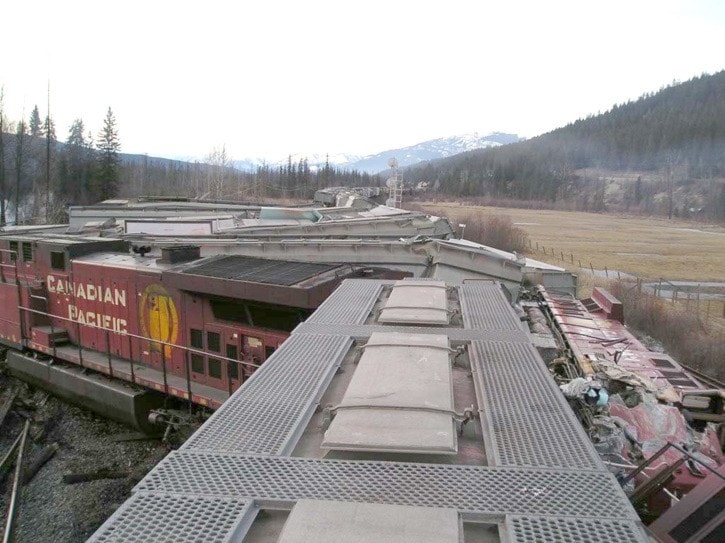Note: Updates at bottom of story.
Marijuana and cell phone use were contributing factors in a Mar. 3, 2010 train wreck near Golden involving crew members from Revelstoke.
A new Transportation Safety Board of Canada (TSB) report into the collision has found the crew’s “situational awareness” was compromised by marijuana and cell phone use, causing them to misread conflicting safety notifications, ultimately missing track-side signals telling them to stop before a controlled intersection.
This failure to stop caused their eastbound train No. 300 to collide with the middle of an oncoming train, which was switching over to a parallel track. The crash caused three locomotives and 26 cars to derail, and touched off a fire when a propane tank near the tracks ruptured. It also spilled about 3,260 gallons of diesel and tonnes of potash.
Although crews from both trains walked away from the wreck, the engineer on the eastbound train later lost consciousness and was rushed to hospital in Calgary. “It was later determined that the locomotive engineer had been exposed to marijuana, sometime prior to the accident,” states the TSB report. “In an attempt to mask this exposure, he drank approximately 10 litres of water shortly after the accident, which resulted in hyponotremia (i.e., water intoxication). The ingestion of water and the delay in alcohol and drug testing likely affected the usefulness of the (drug and alcohol) tests.”
The report also found the crew of train 300 had used their cell phones multiple times just before the crash, up until “about one minute” before receiving a safety message by a monitor just before the crash.
The report found the engineer and conductor were trying to figure out a safety warning that had been electronically relayed to them from a newly-installed but not yet operational “hot box detector.” The detector is a trackside piece of equipment that scans the train for overheating wheel bearings. While trying to sort out the erroneous warning with a signal maintainer, they failed to notice trackside signals telling the train to stop. They also did not “positively identify and announce” the stop signal. Eventually, they hit the emergency brakes, but it was too late.
The report indentified several risks:
- a lack of a timely post-accident drug and alcohol testing regime
- poor coordination of the crash site, including no hazard assessment before local firefighters entered the scene
- “switch heater” propane tanks located too close to the tracks, causing the fire when ruptured
- deficiencies with the system that failed to protect against signal recognition errors
- cell phone usage. Despite some rules against their use while operating trains, “not all railway employees working in safety sensitive and safety critical positions understand and accept the risks associated with such distractions, increasing the risk of unsafe train operations,” the report states.
Results and actions
The TSB report notes CP Rail implemented new, stricter rules regarding the use of personal electronic devices. As of July, 2010, employees are prohibited from using them. They must be turned off and out of sight, unless during breaks or when the trains are stopped.
CP Rail is also planning to implement a new policy in January of 2012 that will provide for “oral fluid” drug testing in addition to existing post-incident drug and alcohol testing procedures.
Other safety steps involve stepping up or reinforcing train communication and operating procedures.
UPDATE: Oct. 6, 4:40 p.m.
Crew involved dismissed from CP Rail
A CP Rail spokesperson has confirmed the engineer and conductor involved in the incident have since been dismissed from the company.
Ed Greenberg stressed the company's safety record as well as compliance with the Canada Transportation Safety Board investigation into the incident. He also emphasized that CP Rail conducted its own internal investigation into the crash and took actions, as was noted in the TSB report. This included new restrictions on the use of cell phones and other personal electronic devices, and amended post-incident drug testing procedures.
"This was considered a significant accident caused by crew errors and it served as a clear and stark reminder why the safety of our employees and the safety of the [communities] in which we operate must be an ongoing commitment," he said.
Engineers and conductors are not subject to random drug tests
Greenberg said that CP Rail conducts drug screenings when hiring employees, as well as after crash incidents. However, he said Canadian law prevented the company from conducting regular or random drug testing on employees, including those who operate trains.
Greenberg said he was not in a position to respond when asked if employees had been disciplined for drug use following other crash incidents in the past.
"This was something that we do not take lightly," Greenberg. "It was serious. Safety is a priority with this company. We are the safest railway in North America and we have been for the past five consecutive years [and] eleven of the past 13. But it was a stark reminder," he said.
